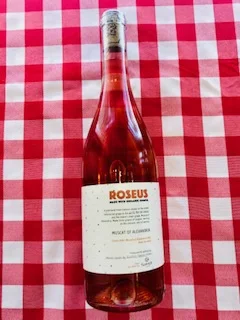Grape Me: Muscat
Free tasting | Saturday, July 13, 2019 | 4-6PM
Muscat of Alexandria
Muscat is one of those chameleon grapes that you’ve probably consumed unknowingly. Truth be told, it’s everywhere! The Muscat grape is old enough to be called ancient (or vintage a few hundred times over!). Wine scholar Jancis Robinson’s hypothesis is that Muscat was once the most common vine imported into southern Gaul by the Romans. To give you an idea of how long ago this was…Gaul existed in the Bronze Age! The Romans then transported and replanted this grape all across Europe where it then eventually traveled across oceans to be grown worldwide. Since it’s so old and well-traveled Muscat is grown under many names including: Moscato, Brown Muscat, Muskatellar, and Moscatel.
Photo credit: Wine Folly
Since this grape is so enviably fabulous and worldly, there are many fabulous and distinctly different styles of Muscat. But no matter where or how Muscat is grown, it is known for two things: a richly intoxicating smell of the grapes on the vine and the grape-y tasting notes of this wine in the glass (think Welch’s grape juice steeped with white flowers and limes). Pliny the Elder actually nicknamed this grape ‘The Grape of the Bees’ because swarms of bumblebees are attracted to the heavy, heavenly aroma in the vineyards. Plus, Cleopatra’s favorite wine was Greek Muscat, or Muscat of Alexandria. And Queens never lie.
Next time your sweet tooth rears its sugary head you should immediately book it to a bottle of Moscato d’Asti. From Piedmont, this style of Muscat (Moscato in Italian) is fizzy, is quite sweet, and thus has a lower percentage of alcohol (5-6% as opposed to dry wine (typically between 11-15%). Moscato d’Asti is generally floral in the nose and has super ripe flavors of stone fruit like peach and apricot.
Photo credit: Wine Folly
Another legendary incarnate of Muscat is from Down Under where the grape is known as Rutherglen Muscat and here, in Rutherglen, Australia is made into ‘stickies,’ an Australian term used to describe fortified wines. Rutherglen Muscat can be aged in barrel from as little as 5 years to decades. If you’re looking for an alternative to Madeira or Port try this! Rutherglen Brown Muscat has notes of caramel, nutmeg, and butterscotch.
If you’re craving some drier Muscat look no further than southern France and Corsica where they grow full-bodied and dry examples of this grape. In Spain you can find off-dry to dry versions of this grape grown under the name Moscatel. Interestingly, while Muscat thrives in warm climates, it is also grown in cooler climates like Austria under the name Muskatellar.
Go to Chile and you’ll be in the land of Pisco, a distilled spirit that is the base for phenomenal cocktails like a Pisco Sour, Chilcano, or a Machu Picchu. But how does this relate to Muscat? In the desert, arid regions of Atacama and Coquimbo, Muscat of Alexandria is one of the three grapes used to create. Curious about trying a Pisco Sour? This is actually my favorite cocktail of mine and if asked I will go into a detailed list of who makes the best Pisco Sour’s in the Boston Area, or hit the spooky streets of Salem tonight and get a stellar Pisco Sour at Ledger!
This Saturday, Susan and I are showing a line-up of Muscat from around the globe, including Greek Muscat of Alexandria, Moscato d’Asti, dry Muscat from Oregon, and Yellow Muscat from Slovenia. See you there!
-Molly
PS – I found this obscure review on a Japanese KitKat bar made with Muscat juice, and I cannot NOT include the link here.
Garalis, Terra Ambera (2018)
Who: Manolis Garalis is a 3rd generation wine grower. He launched his own winery in 2006 and released his first wines in 2007.
What: 100% Muscat of Alexandria
Where: Manolis cultivates Lemnos island’s Limnio and Muscat of Alexandria grapes on 5 hectares of organic property.
How: Stainless steel (7 days with skins), mild temperature control at 21°C, undergoes malolactic fermentation. Bottled unfined and unfiltered with minimal added sulphites.
Farming Method: Organic (certified)
Fun Fact: Terra Ambera refers to the orange sulphuric volcanic soil of Lemnos island.
What It Tastes Like: Classic aromatic and grape-y nose, with slight oxidative nuances, and a round and sharp palate. Summery notes of lime, Starburst, and Fruity Pebbles!
Garalis, Lemnos Roséus (2018)
Who: Manolis Garalis
What: Blend of Muscat of Alexandria with a touch of Limnio grape.
Where: Lemnos island (Aegean islands)
How: Native yeasts, minimal filtration, 5 months in stainless steel.
Farming Method: Organic (certified)
Fun Fact: The altitude of the Muscat of Alexandria vines are planted at 150 meters above sea level, and the Muscat vine ages back to 1972.
What It Tastes Like: Hibiscus tea meets watermelon Jolly Rancher.
Fausse Piste Fish Sauce (2016)
Who: Pacific Northwest Winemaker Jesse Skiles
What: 100% Muscat Blanc á Petits Grains. 380 cases produced.
Where: Eola-Amity Hills AVA (Portland, Oregon)
How: Fish Sauce is a semi-sparkling natural wine made in the Méthode Ancestral method.
Farming Method: Sustainable, leaning towards natural production. “We strive to produce wines that are free of any additives in the cellar, apart from minimal SO2 after fermentation.”
Fun Fact: Jesse Skiles is a chef by trade turned winemaker. His love for French cuisine is also apparent in the French grape varieties that Skiles uses in his winemaking.
What It Tastes Like: Smells like white flowers and peaches, tastes bone-dry with lemony citrus notes on finish.
Gonc Winery, Yellow Muscat (2017)
Who: Gönc winery is a family run winery established in 1936 when current winemaker Peter Gönc’s great grandfather built their first wine cellar and planted the vineyard in the small town of Dobrovnik in Slovenia.
What: 100% Muscat
Where: Ptuj, Slovenia - which is the oldest town in Slovenia.
How: 6 months in stainless steel
Farming Method: Organic
Fun Fact: Gönc is the name for a Hungarian oak barrel, which contains 136 liters. On the 'Gönc Muscat’ wine label, there are 136 dots on each label, with each dot representing 1 Liter of the Gönc barrel.
What It Tastes Like: Limes, lychee, tropical fruits, and apricots. It’s considered dry but has a sweeter finish than I expected.
Vietti Moscato d'Asti (2017)
Who: The Vietti winery traces back to the 19th century, and is now led by the 5th generation Currado clan in the small medieval village of Castiglione Falletto, the heart of Piedmont’s famous Langhe wine region. Here’s a great article about Luca and Elena Currado at Vietti.
What: 100% Moscato d’Asti
Where: Moscato d’Asti DOCG (Piedmont, Italy)
How: Alcoholic fermentation occurs in stainless steel pressured tanks to preserve natural CO2 from the fermentation. The fermentation is stopped at 5% ABV.
Farming Method: Organic/Sustainable
Fun Fact: Try pairing this Moscato d’Asti to Asian cuisine, lobster, or scallops or desserts that are fruit based, or cream heavy. Blue cheese is also an excellent cheese pairing!
What It Tastes Like: It’s Peaches n’ Cream in a bottle! Intense aromas of peaches, rose petals and ginger. On the palate, it is delicately sweet and sparkling with balanced acidity and a fresh finish of apricots.










